Go Back to current column
Announcing…
Unseen Serenissima: The Venice in Winter Photo Workshop
January 12-18, 2013…see below
Recovered Memory
Doing a book of vintage photos of New York and Paris
By Frank Van Riper
Photography Columnist
For New Yorkers of a certain era, meal-time memory recalls doughy and dour women with gunmetal grey fingers.
These were the change-makers at Horn & Hardart, the seminal New York eatery where, besides the steam tables and Salisbury steak, were myriad “automated” vending machines where sandwiches, small crocks of baked beans and pie could be liberated from their individual glass-fronted garages by the mere insertion of nickels. (Note: Though I am sure some of the change-making ladies were comely and smiling, in my memory they always are round, middle-aged and very serious.)
“Automats” were first introduced in the city at Times Square in 1912, and were beloved during the Great Depression for their good, cheap, easily accessible food. They were an instant success. Combined with the take-home “less-work-for-Mother retail shops” the Automats knew their greatest popularity in Manhattan’s victorious post-World War 2 boom economy--the dawn of the hurried white-collar lunch. By the 1950s, with more than 50 restaurants all over the city, they had become a New York icon, like the Staten Island Ferry, the Coney Island parachute ride—even the subway.
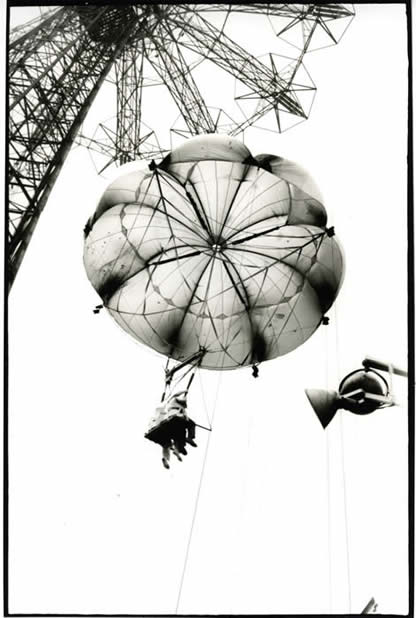 |
| Perhaps a propos for a book of photos on NYC and Paris, the Coney Island parachute ride has been called called Brooklyn's Eiffel Tower. All photos copyright Frank Van Riper. All rights reserved. |
I can’t remember how many meals I had there: first with my parents and later as a college kid. The steam tables were fine for the usual diner fare, but you could go to Bickford’s or Schrafft’s for that. It was the little glass cages—and the hand-cranked coffee spigots in the shape of tiny dolphin heads—that were the real draw.
And for those you needed nickels.
The change-making ladies were always in the center of the restaurant, in an ornate, multi-sided kiosk, one lady facing out from each compass point. They stood before wide marble trays and when you handed one a buck, she would grab a handful of coins from her drawer and, sweeping her hand in front of her, deposit 20 nickels before you in a neat row, without ever breaking a sweat, or a smile.
Doing that eight hours a day gave every change lady I met gunmetal grey, rubber-tipped, fingers.
There’s an Automat wall in the Smithsonian now, though it’s an historic exhibit, not a source of lunch. The Automat—the precursor of fast food—was doomed by the emergence of even faster food: McDonald’s, pizza joints, gourmet lunch trucks. And so the Automat, or at least a piece of it, is now entombed in the National Museum of American History.
So much of what made New York unique before and just after World War 2 is gone now and because of that I am glad I prowled the city of my birth with my first good cameras to steal time and memory.
The fruits of those wanderings—through Central Park, in McSorley’s Ale House, in the old Penn Station, at Coney Island and more—are part of an archive of vintage black and images I am putting together for a book, tentatively titled Recovered Memory. I hope to twin these images, some of them 50 years old—with contemporary images in color.
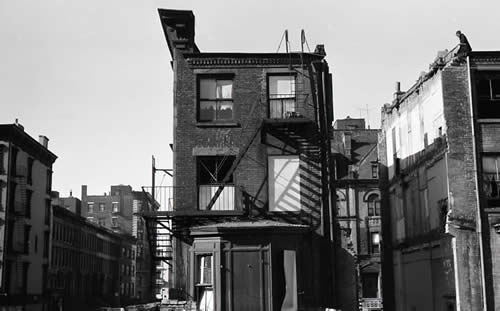 |
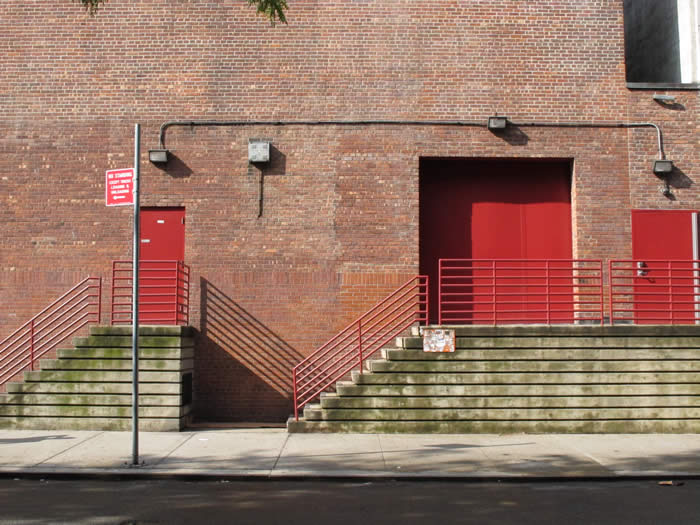 |
| A study in contrast: a view of an abandoned tenement in Manhattan some 50 years ago; a street scene from the same borough today. |
In the same book I hope also to include my vintage pictures of Paris, again with color updates.
I want to do a book on New York and Paris because each city in its way is a beacon of style, culture, brashness and charm. In addition each is ever-changing and each bounces neatly off the other. I come naturally by my love of New York, having been born in Manhattan and having grown up in the Bronx. Though I have traveled and photographed in other parts of France, Paris always draws me back—perhaps as it would any New Yorker. I love Paris for its beauty, its style, its elegant symmetry. The three shooting trips I made there more than three decades ago produced a rich visual archive that at its best rivals my file on New York.
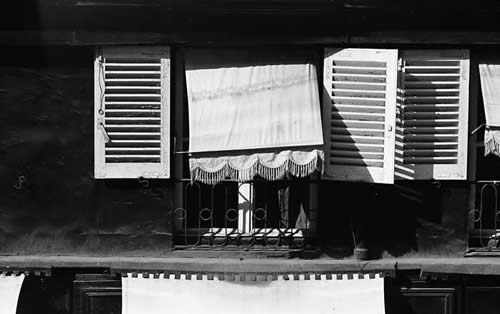 |
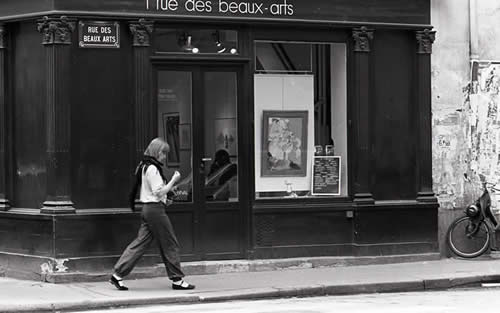 |
| Top: Morning Window/Paris--I love the play of morning light on these windows. Bottom: Frozen in time more than a generation ago, this young woman always will epitomize for me casual Parisian elegance. |
This will be my sixth book, and I have to say I am torn between self-publishing and going through a commercial publisher. I envision the book as somewhat smaller than my last one--describing Venice in Winter (www.veniceinwinter.com). That was a manhole cover-sized hardcover that I did with my wife and partner Judith Goodman. It was printed in Italy and distributed both here and in Europe through a conventional publisher, happily to wonderful reviews.
What I hope for with this book is a small, elegant volume, printed in four-color, for best reproduction of both the black and white and the color. One possible route--and one that might be useful for others thinking of doing a book--is to self-publish a small run of books through one of the higher-end online services (not through the popular but mediocre Burb) and use that book, in effect, as a finished dummy to pitch to a publisher.
Make no mistake: this form of preliminary publishing is itself expensive, and involves more than uploading images to a server using a pre-existing template. Done right, it would mean hiring a designer to make a mockup, then using that design to create a small run of books. Small runs inevitably involve steep unit costs, which is why even comparatively tiny, uninspiring, Blurb books can seem mightily expensive when a friend lets you know he or she finally has (self) published a book of vacation snaps and wants you to buy one.
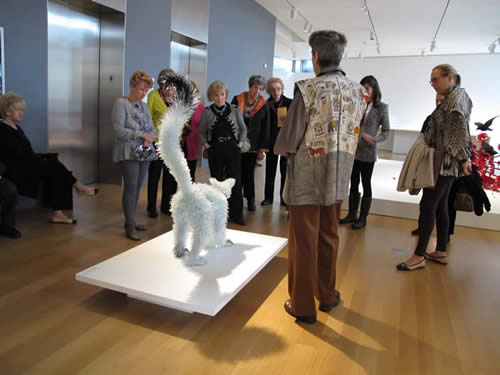 |
 |
| Art critics, now and then: I encountered this colorfully-clad docent at the Museum of Arts & Design, off Columbus Circle; The critics from long ago are at the Guggenheim Museum in New York. (This time the colorful jacket is on the guy.) |
In setting out to do modern photos of New York and Paris, I don’t want merely to make modern clones of the existing black and white. Instead, I hope these new color images evoke in the viewer a feeling for these places today, just as I hope the vintage images evoke a feeling for the New York and Paris of yesterday.
“New York is nothing like Paris; it is nothing like London,” the writer E.B. White said in “Here is New York,” his eloquent postwar essay on the city. “[A]nd it is not Spokane multiplied by sixty or Detroit multiplied by four.” There was and is a palpable uniqueness about New York, formed by its bigness and its diversity, its pace and its expectations. Frank Sinatra’s sung boast, “if I can make it here I can make it anywhere,” is not far wrong. New York expects much but it gives much in return, in the form of confidence, smarts, sophistication—and, it must be admitted, brashness and attitude.
Growing up in the Bronx in the post-World War 2 1950s, I got from my parents an appreciation of music and theater by actually going to the Met and to shows on Broadway. Living within walking distance of Yankee Stadium I saw Mantle and Berra play there in the flesh—but I also saw other Yankee greats like Gil MacDougald and Hank Bauer attending mass at our church, just blocks from the ballpark.
I could not have experienced any of this growing up in Keokuk.
To merely go back and re-photograph, say, a building that happened to avoid the wrecking ball—or, more likely, shoot what is on the site where a building once stood--seems to me a so-what exercise. I did something like that in the 1960s when I worked on the New York Daily News Sunday Magazine as a young reporter. I was in charge of writing the captions for a weekly feature called “New York’s Changing Scene.” The magazine’s staff photographer David McLane would scour photo archives for dramatic photos of the city—the older the better—then go out and shoot the same scene from the same vantage point, always in black and white.
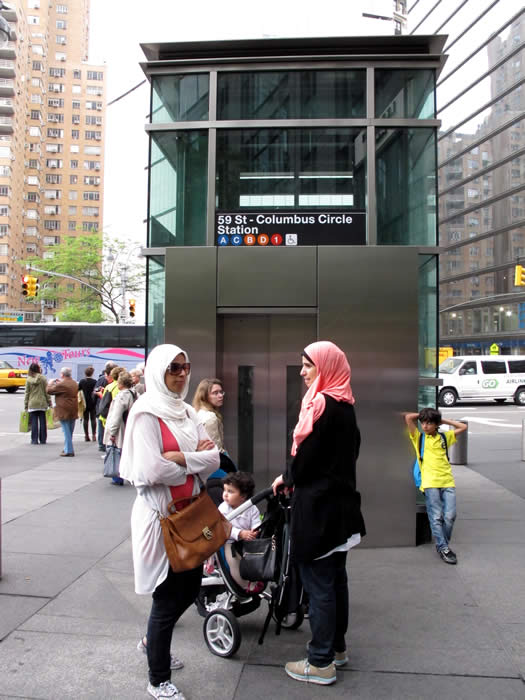 |
| This 'changing scene' illustrates how New York remains even more of a melting pot than the rest of the country. |
It was a fascinating feature and I loved writing the captions for it. But a book like Recovered Memory needs, I think, more evocative images in order to succeed. For example, a photo of a New York subway entrance from the 1960s—looking then like the entrance to one of Dante’s rings of hell--re-shot from the same vantage point today doubtless would show a brighter, cleaner place. But I prefer wholly different images to evoke a newer mood: a young mother with her baby in a snugli walking blithely by huge murals of great-looking dogs in a spanking clean subway station in Manhattan; a man (who admittedly could have come from the 30s or 50s) looking like a marble bust in stoic closed-eyed contemplation on the train, the shiny subway door visible to his left. Or perhaps the most telling image of contemporary (read: post-9/11) underground New York: people rushing up and down a wide clean subway staircase, that bears on its risers the legend in black letters on yellow: “If you see something, say something.”
It may have looked like the Gates of Hell, but it was my mode of transport way back when. What a change 50 years can make.
Then too is the fact that I could not clone some images even if I wanted to. One of my favorite photos in this series is “Ferry Bench, NYC.” It is a moody shot made from above, of one of the old two-sided curved wooden benches on the Staten Island Ferry. I made the picture when I was in high school (I am pretty sure I had cut classes that day with my friend Marty to go out shooting) and wound up straddling an identical bench across the aisle in order to get the angle I wanted. Everything worked that day: the light, the composition—the fact that, even though moving, the ferry was just still enough for the photo to be tack-sharp.
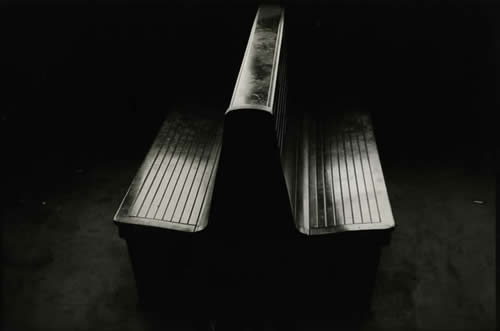 |
| I cut classes with my friend Marty to go out shooting, including on the Staten Island ferry. It was worth it for the shot I made there. |
The Staten Island ferries still run today, but their beautiful wooden benches are no more. Recently I saw one of the ferry’s single benches, not the two-sided version that I photographed nearly 50 years ago, offered for sale on eBay.
In making new color photographs of Paris, I am sure I will face similar circumstances as I wander the streets with a digital Canon G12, not my old-film-eating Nikons, treading familiar ground but looking for fresh images. I have not yet returned to Paris for this part of the project, so all I can do is invite you to watch this space.
For now, I am mining the vaults of memory, enjoying the Paris of a generation past:
The great Paris Metro—it was like going home to a Bronx boy who grew up on the subway. Only in Paris many of the subway cars back then had rubber wheels. There were elegant wooden coaches as well and some cars were designated First Class (“Only the French,” my Francophile friend Neil would say.)
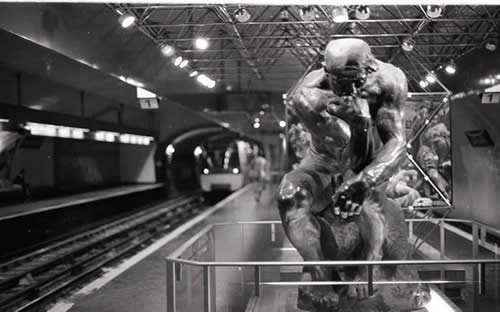 |
| Only the French, perhaps, would have made such an effort years ago to add culture to a subway stop. |
The morning commuters, especially those traveling in First, looked the part of elegant Parisians, though one always could count on the smell of body odor and garlic breath somewhere on the train.
At the other extreme, there was the ambrosial smell of fresh baguettes and croissants every morning from almost every corner. I recall the glory of late night walks along the Seine as the City of Light lived up to its name. And the metallic sound of elevators in the Eiffel Tower, made seemingly from the world’s largest Erector Set, as it loomed over the city large, incongruous and strikingly lovely.
Finally, the serene beauty of the Musee Rodin in the heart of Paris. It was Rodin’s home and it is filled with his sculpted treasures. Rodin, I am happy to say, lived well and was celebrated during his lifetime. My favorite image: a picture I made of a guard sleeping in a chair, his head resting on his fist, unconsciously mimicking the pose of one of Rodin’s greatest works, Le Penseur (The Thinker) sitting in maquette just a few feet away in front of an ornate picture window.
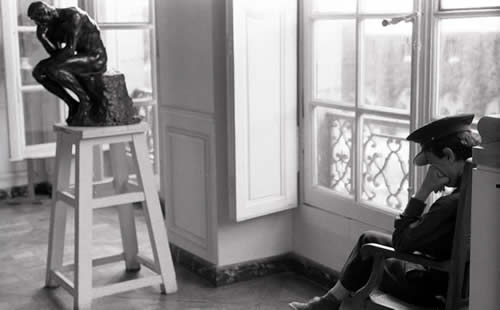 |
| "If conditions are perfect, just make the picture," I once was told. And so I did. |
Unseen Serenissima:
The Venice in Winter Photo Workshop
We have just booked our hotel in Venice and are moving ahead full-steam with putting together what Judy and I believe will be a wonderful week in the Floating City in January.
Following are the key details:
1. Dates: Jan. 12-18, 2013
2. Cost $3,000 per person
3. What's included: First class lodging at the beautiful, centrally located Ai Mori D'Oriente hotel ( http://www.morihotel.com/ ), all breakfasts, three meals (welcome and farewell dinner and one lunch, probably on Murano or Burano) week-long no-limit vaporetto pass, private instruction and tours, daily critiques at the hotel, signed copy of our book, Serenissima: Venice in Winter.
4. Itinerary: we will follow in Judy's and my footsteps as we photographed our book. This means there will be early morning and late-night photo excursions, visits to places tourists rarely travel (the cemetery island of San Michele, for example; the public gardens, I Giardini, the public market La Pescaria, charming wine bars and enoteche.) But we also plan to have at least one guided tour and visits to the more popular sites like Piazza San Marco, the Doge's Palace, the Accademia museum, etc. NOTE: participants also will have free time during the week to use their vaporetto passes and wander this magical place on their own. We will provide what we think is the best tourist map to help navigate.
Note: This workshop is now fully booked. To be placed on a waiting list, or to receive information about the following year's Serenissima workshop, Contact: GVR@GVRphoto.com
Van Riper Named to Communications Hall of Fame
 |
| Frank Van Riper addresses CCNY Communications Alumni at National Arts Club in Manhattan after induction into Communications Alumni Hall of Fame, May 2011. (c) Judith Goodman |
Photography columnist Frank Van Riper, author of the award-winning book Down East Maine/ A World Apart, and others was inducted into the City College of New York Communications Alumni Hall of Fame during an awards dinner at the National Arts Club in Manhattan May 6, 2011.
Van Riper, 65, was cited for is long career in journalism and photography and joins a panoply of other famed CCNY writers and artists named to the Hall of Fame in previous years, including playwright Paddy Chayefsky, muckraking author Upton Sinclair, novelist Oscar Hijuelos and columnist and author Irving Kristol.
Van Riper’s formal journalism career began on the New York Daily News, which he joined in 1967, one week after his college graduation. He stayed with The News for 20 years, serving as White House correspondent, national political correspondent and Washington Bureau news editor. He was a 1979 Nieman Fellow at Harvard, and holds the 1980 Merriman Smith Award (with the late Lars-Erik Nelson) from the White House Correspondents Association for deadline coverage of the negotiations to free American hostages held in Iran during the Carter administration.
In 1987 he left daily journalism for commercial and documentary photography, partnering with his wife, photographer and sculptor Judith Goodman.
In 1992, Van Riper became photography columnist of the Washington Post, where his column, “Talking Photography,” appeared in the Camera Works section of Washingtonpost.com (www.TalkingPhotography.com) His book, Talking Photography, a ten-year collection of his columns and other photography writing, was published in 2001.
Van Riper and his wife are co-authors of Serenissima: Venice in Winter, an internationally acclaimed book of photographs and essays, published in 2008.
In October, 2010, they also inaugurated The Umbria Photo Workshops, their first international photography workshop in Umbria, Italy. www.experienceumbria.com
Every summer they also lead the Lubec Photo Workshops at SummerKeys, a series of low-key week-long workshops based in Lubec, Maine. www.SummerKeys.com
[Copyright Frank Van Riper. All Rights Reserved. Published 8/12
|